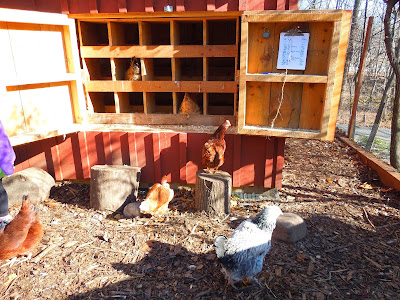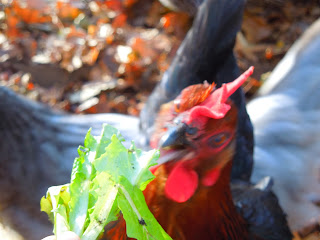 |
| The fenced area in which they keep their chickens in. |
 |
| Top and bottom: The chickens' nesting boxes with 2 of them occupied for the moment. |
 |
| A runaway turkey, in the end it was safely herded back into it's enclosure. |
 |
| Here is the little Golden Sebright Rooster who was quite a cutie, strutting around proudly in his golden dragon scale mail armor. |
 |
| Top and bottom: A Dark Cornish, one of the breeds that I am hoping to get in the future. |
 |
| Submitting to the warmth of the sun. |
 |
| Top and bottom: This beautiful Partridge Rock rooster was pretty careful when eating out of my fingers, and at least he didn't bite a chink out of my finger as the Golden Laced Wyandotte roo did! |
 |
| Just for a hen and rooster comparison, this is one of the Partridge Rock hens at Common Ground. |
A Plymouth Rock is the name of the chicken breed, not a feathering type. The varieties that are accepted in the Standard are: barred, white, partridge, silver penciled, buff, columbian, blue, and black. But keep in mind that these colors are only correct in the United Kingdom, America, and Canada. Australia's Poultry Standard divides the barred variety into two separate colors, dark barred and light barred. I often see many people get confused and call the barred variety a Plymouth Rock, but the Plymouth Rock name is only a breed, not a color variety. The most widely recognized and popular variety of the Plymouth Rock is the barred variety. To learn more about Plymouth Rocks, you should go to the Backyard Poultry site and Newbould's Rocks.
 |
| A Black Star hen with stunningly colored breast feathers being reflected in the sunlight. |
When I had first arrived, the students had thrown in some leftover vegetables on the ground that some chickens were pecking at vigorously and trashing about. And since chickens didn't have hands to tear apart or hold on end of a leaf to rip a leaf into smaller pieces, it was very inconvenient to eat the leftover vegetables. Many of them had long lost interest in the limp figures on the ground. So when I held up a couple of small pieces of what I thought was lettuce, one little Black Star pullet walked up to me, gazing up at the delicious treat. As soon as she started feasting, other chickens caught attention of the event and joined.I also gave the turkeys some greens, they were most of the time ignored by little children visiting the poultry yard who were instead, fascinated by the vast majority of chickens.
 |
| "Food. . ." the Black Star pullet looked at the lettuce piece, with big, bulgy, dreamy looking eyes. |
 |
| A floppy combed Blue Andalusian joins. |
 |
| A curious Red Star enjoys some greens. |
  |
| Top and bottom: A Golden Campine hen scrounging for some veggies on the ground. |
 |
| A Partridge rock hanging around with a Dominique hen. Dominiques are commonly called Barred Rocks, the main difference is that a Dominique has a rose comb and Plymouth Rocks have single combs. |
 |
| A bunch of hens standing around the dustbathing pits. |
 |
| This Buff Orpington here is taking a dustbath, and while the sun shines down on her, she sunbaths as well. |
 |
| A White-Crested Blue Polish. |
 |
| A Splash Andalusian standing near one of the coop openings, hunched up from the cold. |
 |
| This is a hatchery quality Light Brahma. |










No comments:
Post a Comment